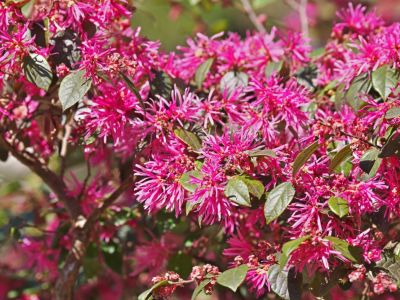About Chinese Fringe Plants
Loropetalum plants are native to Japan, China, and the Himalayas. The plants may be as tall as 10 feet (3 m.) but are usually small trees of 5 feet (1.5 m.). The leaves are oval and glossy green, set on stems with crinkly brown bark. Blooms appear in March to April and last for up to two weeks on the stems. These flowers are 1 to 1 ½ inch (2.5-4 cm.) long and made up of long and slender, strappy petals. Most varieties are white to ivory but there are some Chinese fringe shrubs that are in bright pinks with purple leaves. An interesting fact about Chinese fringe plants is their longevity. In their native habitat there are specimens that are over one hundred years old and 35 feet (11 m.) tall.
Loropetalum Plants
There are several cultivars of Chinese fringe. These include:
The Hillier form has a spreading habit and may be used as a groundcover Snow Muffin is a dwarf plant only 18 inches (46 cm.) tall with small leaves The popular Snow Dance is a dense compact shrub Razzleberri produces bright pinkish red fringe flowers
Whichever cultivar you choose, growing Loropetalum shrubs requires sun to partially sunny locations and organic rich soil.
How to Care for Loropetalum
These plants are low maintenance and not terribly fussy. Their lighting requirements range from part sun to full sun; and although they prefer rich soil, they can also grow in clay. The plants may be pruned to keep them in a smaller size. Pruning is done in early spring and a light application of slow-release fertilizer right around the same time will enhance the plant’s health. Chinese fringe plants are tolerant of drought once established. A layer of mulch around their root zones will help reduce competitive weeds and conserve moisture.
Uses for Loropetalum Shrubs
The Chinese fringe plant makes an excellent border or specimen. Plant them together as a screen or along the edges of the home as foundation plants. The larger cultivars also assume the form of small trees when the lower limbs are removed. Be careful not to over prune as the limbs lose their natural shape. The more adventurous gardener might want to try to espalier these beautiful shrubs or even bonsai the plant for a pot bound display. Growing Loropetalum shrubs as groundcovers is easy if you choose a low growing cultivar like Hillier. Occasionally prune the errant vertical stems to help the appearance.
